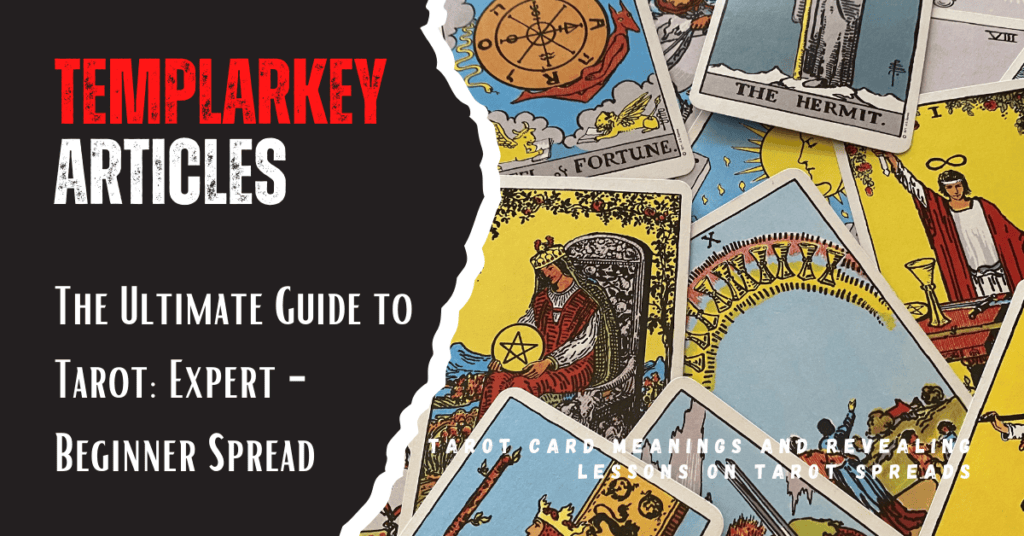The Ultimate Guide to Tarot Card Meanings: Revealing the Mystery of the Tarot Spread, Advanced – Beginner
Tarot has fascinated humanity for centuries. Conceived initially as a deck of cards for a game, it gradually evolved into a tool for divination, mysticism, and personal development. This guide delves into the history of the Tarot, explores the symbolism of the cards, and offers in-depth lessons on how to become a Tarot reader and interpret the Tarot to give a great tarot reading.
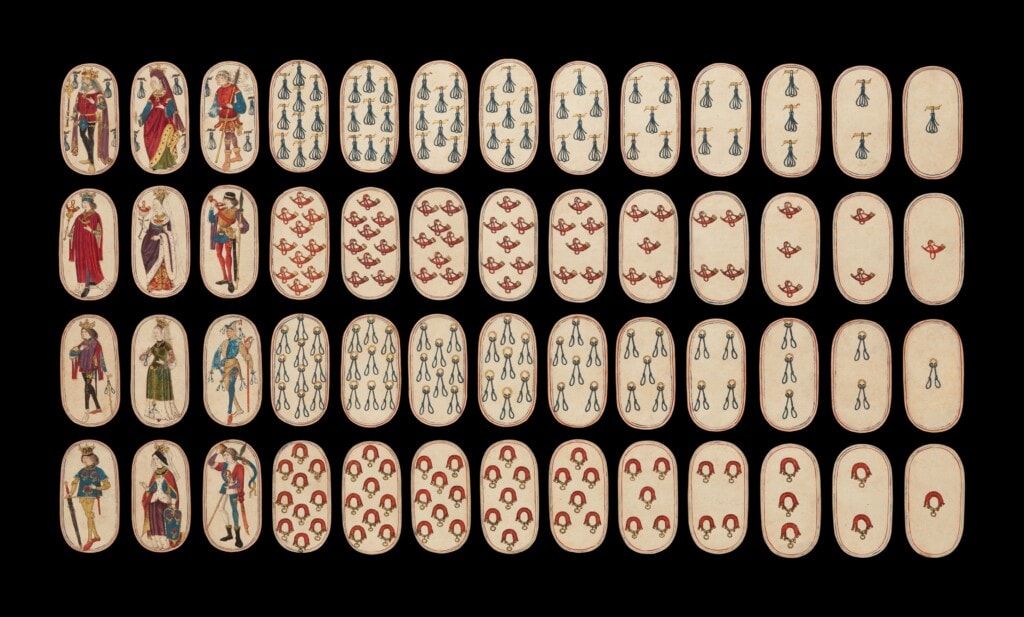
History and revealing the mystery of the Tarot
Origins in Medieval Italy
The Tarot deck began in the mid-15th century in Italy as a deck of cards for the game “Tarocchi,” a popular pastime among Italian nobles. These early decks, called tarocchi cards, were elaborately designed and handmade for wealthy families. The most famous of these early decks is the Visconti-Sforza deck, commissioned by the rulers of Milan. The Tarot of the time was not used for divination but rather as a playing card deck. It wasn’t until the 18th century that the Tarot became associated with mysticism and the occult.
Tarot and the Occult: 18th-20th Centuries
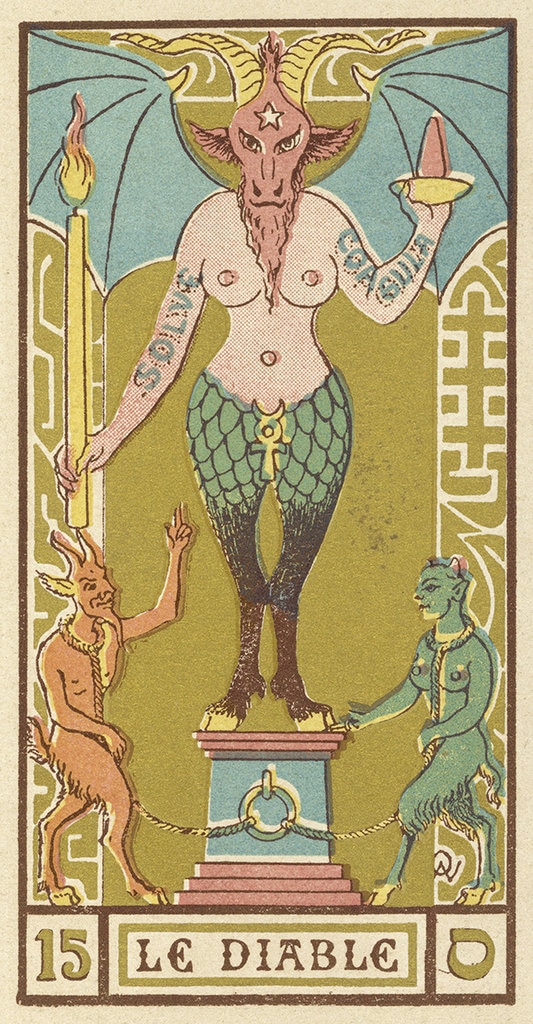
The association of the Tarot with occult practices began in the late 18th century with Antoine Court de Gébelin, a French cleric and Freemason who theorized that the Tarot was an ancient Egyptian wisdom text. Though no historical evidence supports this claim, his works linked the Tarot to esotericism, Kabbalah, and astrology, marking the start of the Tarot’s mystical journey.
In the 19th century, Eliphas Lévi, an influential occultist, linked the Tarot’s Major Arcana to Kabbalah and astrological symbolism, further embedding the Tarot in esoteric tradition. This great epoch saw the Tarot become a tool for divination and spiritual guidance. The Rider-Waite Tarot deck (published in 1909) is one of the most popular decks in modern times.
Created by Arthur Edward Waite and illustrated by Pamela Colman Smith, this deck’s imagery was rich in symbolism and corresponded with occult and astrological teachings. For more on the history of the tarot, see our other article; click here.
Tarot in the Modern Age
Today, the Tarot is used equally for self-reflection, personal insight, psychological exploration, and divination tools. Thanks to its growing popularity, the Tarot has evolved beyond esoteric circles and is now a part of modern spirituality, personal development, and creative practices.
Understanding the Structure of the Tarot Card Deck
The Tarot consists of 78 cards, divided into the Major and Minor Arcana.
Major Arcana: The Journey of the Fool
The Major Arcana consists of 22 Major Arcana cards, beginning with The Fool and ending with The World. These cards represent significant archetypes and major life events. They tell the story of the Fool’s Journey, symbolizing the human experience from innocence and naivety (The Fool) to enlightenment and completion (The World).
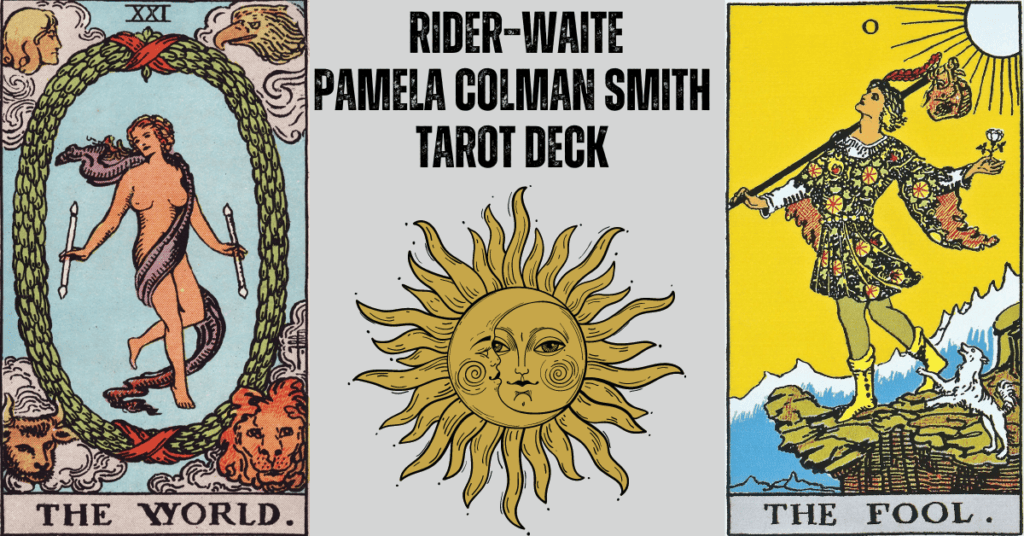
Key cards include:
- The Magician: Mastery of one’s environment
- The High Priestess: Inner wisdom and intuition
- The Hierophant: Tradition and Spirituality
- Death: Transformation and endings
- The Tower: Sudden change and disruption
- The World: Completion and wholeness
Minor Arcana: The Four Suits
The Minor Arcana consists of 56 cards, divided into four suits: Wands, Cups, Swords, and Pentacles. Each suit is linked to a different element and focuses on aspects of everyday life:
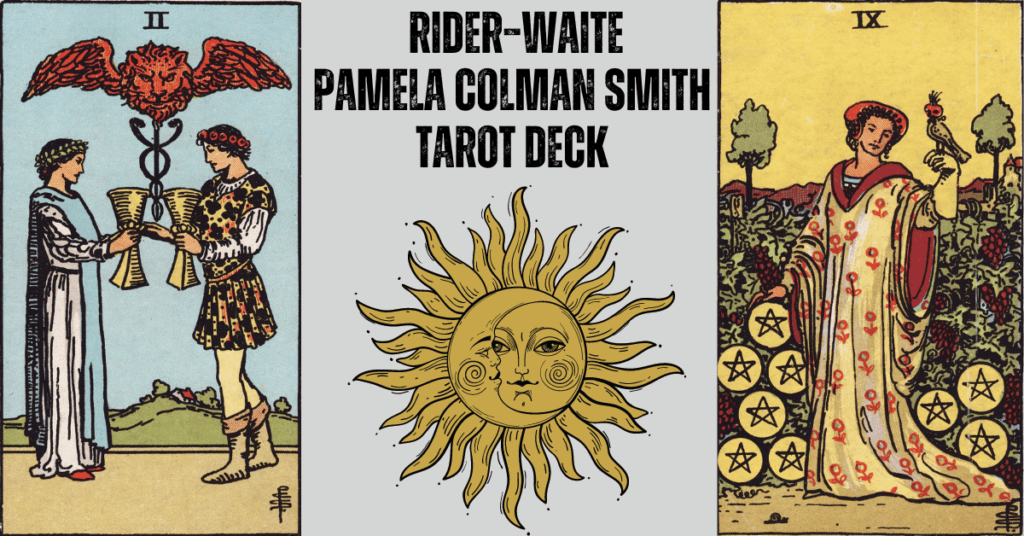
- Wands (Fire): Action, creativity, passion
- Cups (Water): Emotions, relationships, intuition
- Swords (Air): Intellect, conflict, analysis
- Pentacles (Earth): Material wealth, career, stability
Each suit has numbered cards (Ace through Ten) and Court Cards (Page, Knight, Queen, King), representing different personality archetypes and stages of development.
Court Cards and Their Roles
The Court Cards (Page, Knight, Queen, and King) are often misunderstood but play a critical role in readings. They can represent people, stages of life, or aspects of the querent’s personality:
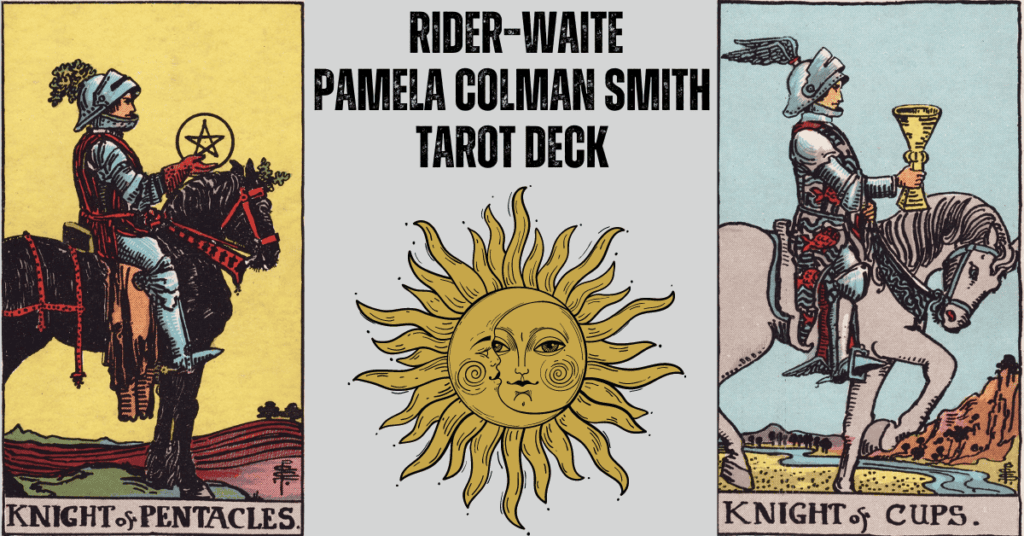
- Pages: New beginnings, messages, and youthful energy
- Knights: Action, ambition, and pursuit of goals
- Queens: Nurturing, creativity, and inner mastery
- Kings: Authority, control, and leadership
In-depth lessons and Ultimate Guide to Tarot card meanings and Tarot Interpretation
Lesson 1: The Importance of Intuition
While learning the traditional meanings of the cards is essential, the real key to Tarot reading is intuition. By tapping into your inner voice and interpretation skills and connecting to the imagery on the cards, you can offer readings that resonate on a deeper, personal level. Intuition guides the interpretation of card combinations and spreads.
Tarot works as a mirror to your subconscious, reflecting what is often hidden beneath the surface. When reading tarot cards, trust your first instincts and impressions as you interpret them.
Intuition allows you to go beyond textbook definitions and see how the cards speak to you in the moment. This means paying attention to feelings, thoughts, or images that arise as you look at a card. For example, if The Lovers card comes up in a reading, its meaning might shift depending on how you feel drawn to certain symbols or the surrounding cards in the spread.
Try practising with mini-layouts or card spreads that encourage self-reflection to strengthen your intuitive tarot reading. Let go of trying always to be “right” and allow yourself to be open to what the cards are communicating. Over time, as you deepen your connection with the cards, your intuitive insights will flow more naturally, guiding you to more accurate and meaningful readings.
The art of tarot reading is a balance of knowledge and intuition. You combine the three essential ingredients, the cards, your knowledge, and your gut instincts, to uncover the truth hidden within each spread.
Lesson 2: Reading Individual Cards
Start by focusing on the imagery, colours, and symbols in each card. For instance:
- The Empress: A lush garden and wheat indicate abundance and fertility.
- The Hermit: The lantern he holds represents wisdom guiding the way through darkness.
- The Fool: A young figure stands at the edge of a cliff, representing new beginnings and leaps of faith. The white dog by their side symbolizes loyalty and protection, urging the Fool to trust in the journey ahead.
- The Magician: The figure holds a wand pointing to the heavens, while the other hand points to the earth, representing the flow of divine energy into the material world. The tools on the table—cup, sword, pentacle, and wand—indicate mastery over all elements and the power to manifest one’s will.
- The High Priestess: She sits between two pillars, representing balance and duality, with a veil behind her suggesting hidden knowledge. The scroll in her lap signifies divine wisdom, and the moon at her feet links her to intuition and the subconscious.
- The Lovers: A man and woman stand before an angel, symbolizing divine union and love. The mountain in the background represents challenges, while the apple tree with a serpent reminds us of the need for choices guided by values and integrity.
- The Chariot: A warrior rides a chariot pulled by two sphinxes, symbolizing control over opposing forces. The armour represents strength and determination, while the stars above indicate the guiding power of higher goals and purpose.
- Strength: A woman gently tames a lion, symbolizing inner strength and the ability to control one’s passions and instincts with grace. The infinity symbol above her head reflects the eternal nature of this balance between courage and compassion.
- The Wheel of Fortune: The rotating wheel represents the cycles of life—ups and downs that are part of the natural order. The creatures around the wheel represent knowledge and divine forces influencing fate, reminding us of life’s ever-changing nature.
- Death: A skeletal figure in armour rides a white horse, representing the inevitability of transformation and endings. The rising Sun in the background symbolizes renewal and the promise of new beginnings after change.
- The Star: A woman kneels by a pool, pouring water into the pool and onto the land, symbolizing healing and rejuvenation. The stars above her head represent hope, guidance, and a connection to the spiritual realm.
- The Tower: A lightning bolt strikes a tower, causing figures to fall, representing sudden upheaval or disruption. The flames and crumbling structure signify the breakdown of false beliefs or illusions, leading to transformation and growth.
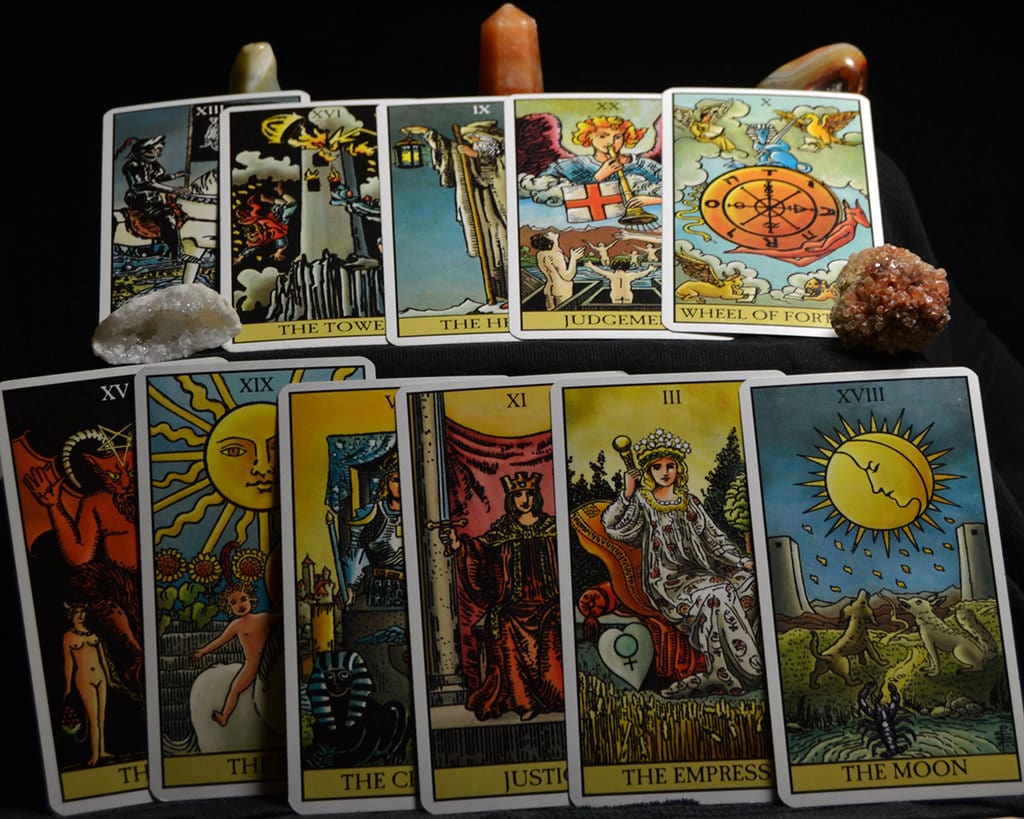
Lesson 3: The Power of Reversals
In Tarot, cards can appear upright or reversed. Reversed cards can suggest blocked energy, challenges, or the opposite of the upright meaning. For example:
- The Sun upright represents joy and success; however, reversed, it may indicate delays or temporary setbacks.
- The Fool upright represents new beginnings and leaps of faith. When it appears reversed, it can signal recklessness or hesitation. Suggesting acting impulsively without preparation or a fear of moving forward and cautioning against unwise decisions.
- The Magician upright represents manifestation and skill. When reversed, it shifts to signify manipulation or misuse of power, indicating a lack of focus or the potential for dishonesty, suggesting someone may be using their talents for deceptive purposes.
- The Lovers upright represents love, harmony, and meaningful choices. On the other hand, reversed often points to disharmony or conflict, highlighting misalignment in relationships or poor decision-making and indicating struggles with commitment or trust in relationships.
- The Chariot upright represents control and victory. Reversed, it suggests a lack of direction or feeling overwhelmed. It warns of losing focus or being unable to steer life in the right direction, signalling challenges in maintaining control.
- Strength upright represents the symbolism of inner strength and compassion. When reversed, it reflects self-doubt and an inability to harness inner courage. It suggests weakness or difficulty in managing emotions, indicating that fears may be overpowering resilience.
- The Wheel of Fortune upright represents the natural cycles of life and luck. Reversed, it can suggest resistance to change or feeling stuck in a negative cycle, signalling bad luck or challenges outside one’s control, urging acceptance of life’s ups and downs.
- The Star upright represents hope and healing. Reversed, it may signify a loss of faith or disconnection from inner guidance, suggesting discouragement or difficulty seeing the light ahead, indicating the need to reconnect with inspiration and optimism.
- Death upright represents transformation and the end of a cycle. Reversed, it often signals resistance to necessary change, suggesting fear of letting go or stagnation, where progress is blocked due to unwillingness to embrace the process of transformation.
- The Tower upright represents sudden change and the breaking down of false structures. Reversed, it can indicate an attempt to avoid or delay an inevitable upheaval, suggesting resistance to facing truths or holding on to things that need to be released.
Lesson 4: Tarot Spreads: Beginner to Advanced
Common spreads include:
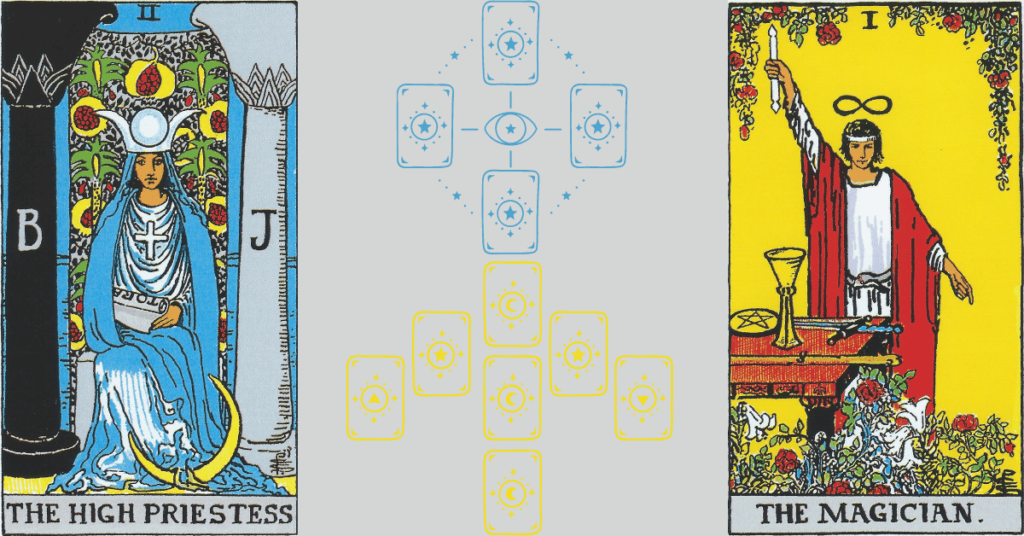
One-Card Draw: For daily guidance or insight. This spread is perfect for daily guidance or insight into a specific question. For example, if you’re wondering what energy or lesson to focus on today, you might draw The Star. This card would suggest that today is a day for hope, renewal, and healing, encouraging you to embrace optimism and faith in the future.
Three-Card Spread: Past, Present, and Future positions. In this spread, each card represents a different time frame—past, present, and future—giving you a clear snapshot of a situation. For example, if you’re asking about a recent relationship:
- The card in the Past position might be The Lovers, indicating a strong connection or important decision made in the relationship.
- In the Present position, you could draw The Hanged Man, suggesting a period of waiting or sacrifice, with the need to see things from a new perspective.
- The card in the Future position might be The Tower, pointing to a potential upheaval or change that will lead to transformation, urging you to prepare for significant shifts ahead.
Celtic Cross Spread: A 10-card spread is ideal for exploring complex situations and examining multiple layers of influence, challenges, and potential outcomes. For example, if you’re seeking insight into a career decision:
- Card 1 (Present Situation): The Chariot, representing determination and the drive to move forward in your career.
- Card 2 (Challenge): The Five of Wands, indicating competition or conflict in the workplace.
- Card 3 (Subconscious Influences): The High Priestess, symbolising hidden wisdom or intuition guiding your decisions.
- Card 4 (Past): The Eight of Pentacles, showing that hard work and dedication have shaped your current position.
- Card 5 (Conscious Goal): The King of Pentacles, reflecting a desire for financial stability and leadership.
- Card 6 (Future): The Wheel of Fortune, indicating that upcoming changes are beyond your control, with cycles of good fortune ahead.
- Card 7 (How You See Yourself): The Page of Swords, suggesting curiosity and readiness for new challenges or ideas.
- Card 8 (External Influences): The Emperor, symbolizing authority figures or structured environments influencing your decisions.
- Card 9 (Hopes and Fears): The Nine of Swords, revealing anxiety about possible failures or setbacks.
- Card 10 (Outcome): The Sun, indicating success, clarity, and joy in the outcome of your career decision.
Lesson 5: Combining Cards for Deeper Meanings
Pay attention to how the cards relate to each other. For example:
- The Chariot with The Lovers may suggest taking control of a relationship situation or moving forward in harmony.
- The Empress and The Hermit: When these cards appear together, they may reflect a time of nurturing your inner world. The Empress symbolizes abundance, growth, and care, while The Hermit indicates introspection and seeking wisdom. Together, they could suggest taking time to reflect on self-care or spiritual development, finding a balance between tending to the material and the spiritual.
- The Tower and The Star: This powerful combination shows the cycle of destruction and renewal. The Tower represents sudden upheaval or the breaking down of old structures, while The Star offers hope and healing in its aftermath. Together, they suggest that although a significant change or disruption may feel overwhelming, it will ultimately lead to clarity, recovery, and a renewed sense of purpose.
- The Devil and The Lovers: These two cards can offer deep insights into relationships. The Devil represents bondage or unhealthy attachments, while The Lovers symbolise choice and harmony in relationships. Combined, they may suggest examining whether a relationship is based on love and balance or has become codependent or toxic, urging you to break free from destructive patterns.
- The Hanged Man and The Wheel of Fortune: These cards together indicate that while you may feel stuck or in limbo (The Hanged Man), change is coming (The Wheel of Fortune). It may not be within your control, but this combination suggests that surrendering to the present moment will allow the natural cycles of life to bring movement and shift circumstances for the better.
- The Sun and Strength: This positive combination emphasizes personal empowerment. The Sun represents joy, success, and clarity, while Strength signifies inner courage and resilience. Together, they indicate that you have both the confidence and the inner strength to face any challenges and emerge victorious, radiating positivity and confidence.
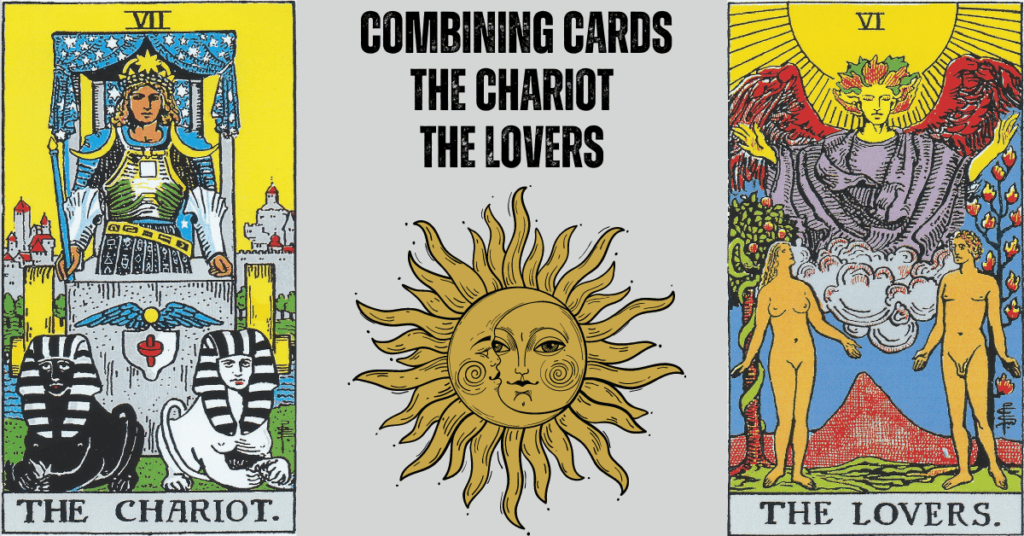
The Major Arcana: Symbols, Archetypes, and Meanings of the Tarot Deck
Each of the Major Arcana cards represents universal archetypes and spiritual lessons. Here are the key themes and symbols for some important cards:
- The Fool (0): New beginnings, innocence, and potential. The Fool’s leap symbolizes taking risks without knowing the outcome.
- The Lovers (VI): Choice, partnership, and harmony. This card often represents the alignment of values.
- The Wheel of Fortune (X): Change, cycles, and destiny. This card represents the inevitable ups and downs of life.
The Minor Arcana: Everyday Life in Tarot
Wands: Fire, Creativity, and Action
- Ace of Wands: New opportunities and inspiration.
- Five of Wands: Conflict, competition, or creative brainstorming.
- Ten of Wands: Burden, responsibility, and hard work.
Cups: Water, Emotions, and Relationships
- Ace of Cups: New emotional experiences or relationships.
- Three of Cups: Celebration, friendship, and joy.
- Ten of Cups: Harmony, family, and emotional fulfilment.
Swords: Air, Intellect, and Conflict
- Ace of Swords: Clarity, truth, and intellectual breakthroughs.
- Five of Swords: Conflict, defeat, or betrayal.
- Ten of Swords: Endings, rock-bottom, and painful conclusions.
Pentacles: Earth, Material Wealth, and Stability
- Ace of Pentacles: New financial or material opportunities.
- Five of Pentacles: Hardship, loss, and financial instability.
- Ten of Pentacles: Wealth, family legacy, and long-term success.
Building a Tarot Practice and Your Tarot Journey
How to Develop Your Own Rituals
Your Tarot practice should be personalised. Create a quiet, sacred space, and consider lighting candles or burning incense before reading. This Tarot Guide has given you much information; however, you must make the cards work for you through practical and intuitive practices.
Journaling for Deeper Understanding
Keeping a Tarot journal is a powerful way to track your insights. Record your daily draws, spreads, and personal interpretations and make notes of this Tarot Guide to help you.
Beyond Fortune-Telling: Tarot for Self-Development and Meditation and Astrology
Tarot can be used as a mirror for self-reflection, revealing hidden aspects of your psyche and guiding you in personal growth. It can also be used as a tool for meditation, focusing on individual cards to gain insight into their deeper meanings. For another of our articles on the Tarot, “Magical Tarot Cards, Explanations and Tarot Deck Origins, Love or Hate The 78”, click here. If you want to go beyond this Tarot Guide, see Issue 2 (January 2022) of the Templarkey Magazine; click here.
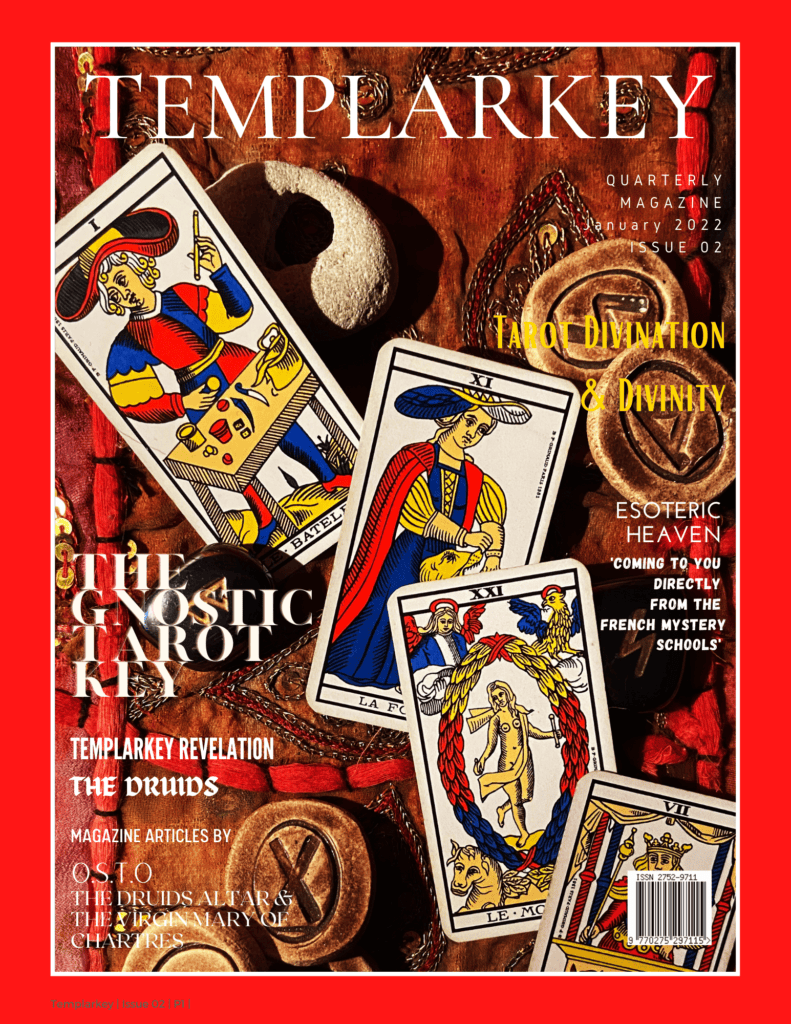
This ultimate guide is a must-have companion for learning to read the cards and offers a comprehensive exploration of Tarot, from its historical roots to its symbolic depth. Whether you’re a novice or a seasoned practitioner, the Tarot’s imagery and lessons can inspire you to embark on your journey of discovery.
Tarot has a deep heritage rooted in mysticism, offering a fascinating blend of spiritual insights, symbolism, and numerology. To learn Tarot as a divination tool, one must first understand themeanings of every tarot card, mainly focusing on the Major Arcana, which contains the most profound life lessons.
Reading Tarot requires knowing the meaning of both upright and reversed meanings, which adds complexity and depth to interpretations. Classic Tarot spreads like the Celtic Cross help guide seekers through significant life questions, while mini-layouts provide easy-to-use options for quick insights, such as a year ahead prediction. The art of tarot reading is a skill that takes time to develop, but tarot experts often advise beginners to start by studying the basic symbols and numbers.
Kabbalistic Use and Numerology
For those who wish to delve deeper into the esoteric side of Tarot, the Kabbalistic approach offers a spiritual synthesis that ties tarot cards to Kabbala and the Tree of Life, linking them to spiritual paths and divine attributes. Each card of the major arcana can be associated with one of the ten Sephiroth or the connecting paths between them, combining spiritual elements and numerology to enhance readings.
We hope this Ultimate Guide to Tarot includes all the classic tarot traditions so you can combine the three essential ingredients of symbols, numbers, and intuition to provide you with a holistic view. Tarot reading also includes using divination with crystal grids, numerology, and links to astrology to deepen one’s understanding of the cards further.
Concluding thoughts
Practical techniques in Tarot include the use of card layouts or spreads, which are specific ways of placing the cards to reflect different aspects of a question or situation. The Celtic Cross, for example, is one of the most popular classic Tarot spreads, designed to provide a comprehensive view of a person’s current circumstances and future outcomes.

Other options for card layouts include the three-card spread for past, present, and future, which is a quick, easy-to-use method for gaining insight into a specific issue. Mini-layouts such as this are often suggested for beginners who want to try more straightforward spreads before advancing to more complex ones.
The art of tarot reading can also involve experimenting with different spreads for every kind of reading, such as love, career, or spiritual guidance. The Horseshoe spread, for instance, offers a comprehensive yet easy-to-use approach for problem-solving, while the Year Ahead spread gives insight into what to expect over the next twelve months.
These techniques deepen the reader’s connection to the cards by teaching them to combine the three essential ingredients of intuition, symbols, and the cards’ positions to uncover layers of meaning. Through practice, one can truly learn how to combine these elements to give accurate and meaningful readings. For another of our articles on the Tarot, “Magical Tarot Cards, Explanations and Tarot Deck Origins, Love or Hate The 78”, click here. If you want to go beyond this Tarot Guide and enter into the philosophical and theurgical path of the Tarot, see Issue 5 (October 2022) of the Templarkey Magazine; click here.
